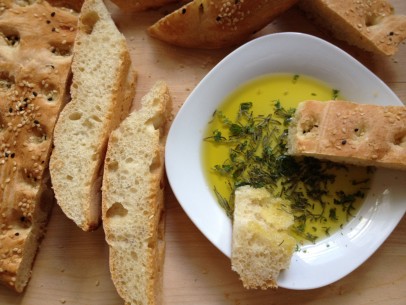
How to Be A Good Greek Cook – Join the #GreekCookingChallenge in 2014
Greek Cooking Challenge
March 2014
Lagana Bread ~ For Lent
Lagana (λαγάνα) is a bread traditionally made on Clean Monday and eaten during the fasting period of Great Lent.
To be completely honest, I have never tried Lagana. I don’t know what it should taste like and I have never seen anyone bake it before. Although no one in my family has ever made Lagana, it is actually a traditional recipe in Greece. Many people make this special bread on Clean Monday which is the first day of the fasting period. I know that I have posted this recipe a few days after Clean Monday, however I would still like to bake it anyway. If we practice baking Lagana this year, then we will be prepared and ready for next year to make it again. Like I have said before, it is better to make your dish a little late, rather than not make it at all. The purpose of the Greek Cooking Challenge is to learn How to Be A Good Greek Cook and I need all the practice that I can get!
If you haven’t already signed up to the Greek Cooking Challenge then
HERE IS THE LINK TO JOIN NOW
It’s not too late… don’t be shy… anybody can do it!
Step 1: Recipe
The recipe that I will use is from Kiki, from the blog called The Greek Vegan. Kiki reccomends this recipe for people who are afraid of baking bread but really would like to learn. She says that because lagana is a traditional flatbread there isn’t the pressure of waiting for a high risen loaf or the disappointment when that doesn’t happen. It is a really easy recipe to make and it’s great for first time bread bakers.
Lagana is also a great recipe to make with kids – they can get into the dough and have a play with it. If the couch is a bit overworked, it will be ok because it is a flab read and lagana dough is very forgiving. It can be heaps of fun for the kids to add the fingerprints in the dough before baking as well as brushing on the apricot wash and sprinkling on the sesame seeds!

Lagana ~ Greek Bread to Eat During Lent
Recipe By The Greek Vegan
Ingredients
- 3 1/2 cups all-purpose flour / variations 1 cup AP/ 1 cup barley flour, 1 cup AP, 1 cup semolina
- 1 1/2 tsp yeast
- 1 tsp sugar
- 1 1/3 cups warm water (not too hot!)
- 1/2 tsp salt
- 1 tbsp olive oil (you can omit olive oil and add additional 1/4 cup of water to recipe)
- (an additional up to 1/2 cup of flour for kneading)
- 1/2 cup sesame seeds (white or black or combination of both)
For bread wash (enough for 2 or 3 loaves)
- 2 tbsp apricot jam or honey
- 1/4 cup boiling water
Instructions
Combine yeast, sugar and water. Set aside for 10 minutes for the yeast to activate of proof. Small bubbles will form on the surface when the yeast is activated. If no bubbles form after 10 minutes, your yeast may be too old. Do not use unless the yeast has proofed.
Combine flour and salt and add yeast/water once it has proofed. Mix well until you have a sticky dough. Turn dough out onto a floured surface and knead for approximately 10 minutes until the dough is smooth and holds together in a ball.
Place ball of dough in a large bowl that has been very lightly greased with olive oil (or dusted with flour) and cover with clean dish towel or plastic wrap and leave in a warm spot in your kitchen to rise. This should take about an hour to and hour and a half. The dough will double in size. Gently poke your finger into the dough to test if its fully risen. If the dough bounces back immediately, your dough needs more time to rise. The dough should rise just halfway after you remove your finger.
In the bowl, knead the risen dough a few times to deflate it and then turn out onto your pan. Gently stretch and pat your dough into a rectangle. Use your fingertips to press small grooves in the dough.
Let lagana dough rest, covered, and rise for another half hour.
To make bread wash simply combine jam or honey with boiling water until diluted.
Lightly brush with apricot wash, sprinkle with sesame seeds and bake at 400 degrees for 30 minutes until golden brown. Remove from pan to cool. Let rest at least 5 minutes before slicing.

Thank you to The Greek Vegan for sharing her recipe with us. You can follow The Greek Vegan on Facebook and on Twitter for more great recipes!
Step 2: Cook!
Our lives these days are so busy with lots of stuff to do, so just pick a day, any day you have free time, and cook away! As I mentioned earlier, the Lagana is usually prepared for Clean Monday but you can try this any time throughout the month of March for the Greek Cooking Challenge.
Step 3: Take A Photo and Share It
Now that your Lagana is ready, take a photo of it! You might like to snap a few shots during the cooking process. If you are using a secret ingredient in your recipe then take a photo of that too. Be sure to share your photo on social media with the hash tags #greekcookingchallenge and #lagana. You can share it on Instagram, Twitter or Facebook.
Or if you prefer to keep your pictures private, then send an email directly to Sia@greekweddingtraditions.com.
Step 4: Receive Your Gift
At the end of the month, the Greek Cooking Challenge subscribers will receive a pdf ebook of the Lagana recipe enhanced with all your comments, secrets and notes, all gathered together and garnished with your new years bread photos. By the end of the year, you will have the perfect ebook of Greek food recipes, with home-made pictures and secrets form within the kitchen of our subscribers. This gift will only be sent to you if you officially join the Greek Cooking Challenge – so if you haven’t already, you can still Sign Up Now!
~*~
The Greek Cooking Challenge is all about Learning How To Be A Good Greek Cook.
Here on the blog, we can all help each other to learn how to be good Greek cooks together.
So don’t forget to share your thoughts throughout this Lagana month, your cooking experiences, tips and recipe secrets. Share the things that have gone wrong or perfectly right with your recipe, so we can all learn from each other!
Good Luck Everyone!
~*~
Related posts you might love:
 Sia Aristidou is fascinated by the rituals and traditions celebrated in Greek culture. Sia writes about love, marriage, family and tradition and sells beautiful handmade wedding gifts at the Greek Wedding Shop.
Sia Aristidou is fascinated by the rituals and traditions celebrated in Greek culture. Sia writes about love, marriage, family and tradition and sells beautiful handmade wedding gifts at the Greek Wedding Shop.
Learn More About Greek Weddings & Traditions
Subscribe to the Blog and Follow Us:












 Sia Aristidou is fascinated by the rituals and traditions celebrated in Greek culture. Sia writes about love, marriage, family and tradition and sells beautiful handmade wedding gifts at the
Sia Aristidou is fascinated by the rituals and traditions celebrated in Greek culture. Sia writes about love, marriage, family and tradition and sells beautiful handmade wedding gifts at the 



